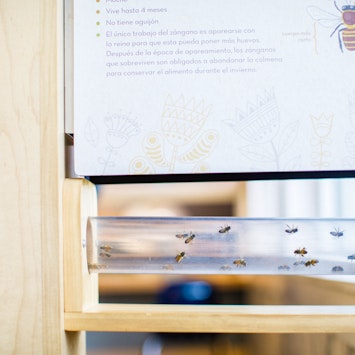Get to know some of our favorite creepy crawlies at Discovery Place Nature
Get to know some of our favorite creepy crawlies at Discovery Place Nature
Discovery Place Nature

Most things are not as bad as they seem… right? You may need to remind yourself of that when you’re at the Museum and eight rose-hair tarantula eyes are staring back at you. But, spiders and many of their creepy crawly friends are using their multiple legs, eyes and stomachs to make our planet a better place to live.
Slither-in is in the house
Slide into Creature Cavern at the Museum and you’re sure to see some legless friends that are known to give many humans ‘the creeps.’ Corn, copperhead, black rat and king snakes are often on exhibit and are native to the Carolinas. Plus, don’t miss seeing the new addition to the family, a milksnake.
Snakes play an important part in our ecosystem. Try to think of them as your friendly neighborhood pest control, gobbling up mice and rats and keeping prey numbers at a level that is healthy for everyone.
Did you know that some non-venomous snakes hunt venomous snakes? Cue gratitude from the humans.
Watch me whip whip
Another creepy species at the Museum is the whip scorpion, sometimes called a vinegaroon (arachnids that have a similar appearance to true scorpions, but do not possess a venomous sting). The whip is not venomous, but they can spray an acidic mix that smells like vinegar.
While they may take the title of ‘super-scary-looking-but-can’t-harm-you,’ vinegaroons enjoy a nighttime diet of grasshoppers, cockroaches and sometimes worms and slimy slugs – which gets a big daytime thumbs-up!
Insect Alley is home to anything that scurries, including Madagascar hissing cockroaches, Dubai cockroaches, Darkling beetles, millipedes and more.
Another great way to experience creepies close-up is during one of the many Live Animal Encounters with a naturalist – you never know who you may meet.
More Than Lettuce Munchers
Speaking of slugs, some people are grossed out by the slimy critters and with all the rain we’ve had in Charlotte recently you’re probably seeing a lot of them. Slugs are mollusks – a title given to ‘stomach walkers,’ (Who knew, right?) and their mucus-bound bodies help them slide to their destination.
Did you know slugs find their slug friends by following each other’s slime trails? (Annnnd, bad news note: Predatory snails find their slug prey by doing the same). No one ever said making friends in the garden would be easy. So, give slugs some love next time you see them - they provide food for all sorts of mammals, birds, slow worms, earthworms and insects, making them a very important player in a balanced environment.
You can learn more about slugs, snails and other creatures in Our Big Backyard and on the Paw Paw Nature Trail.
Heebie-jeebies
If bees give you the heebie-jeebies consider what is really scary: Their numbers are declining rapidly and honey bees are the most important pollinator of food crops. No bees, no food. It is estimated that one third of the food we consume each day relies on pollination mainly by bees, but also by other insects, birds and everyone’s favorite scare-meister, bats (which actually makes them the bee’s knees).
Did you know Discovery Place Nature is lucky to maintain three hives and, just last year, began harvesting their honey to sell? Learn more during one of the Meet-the-Bee Keeper talks, and next time you try to swat or squash a bee, take a moment to consider that it may be on its way to help you out.
Forget the Addams Family
Don’t miss other creepy Museum family members, including an American alligator, during a live Animal Feeding. And, be sure to stop into the Naturalist Lab to explore and observe everything that goes bump in the day and night – including an incredible close-up of the honey bees at work, skull models, scat samples, and the Wentz-scope, which is easy-to-use and fully equipped so you can zoom in on creepy Carolina critters like bugs and snake skins.

